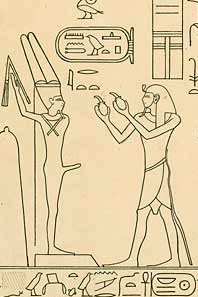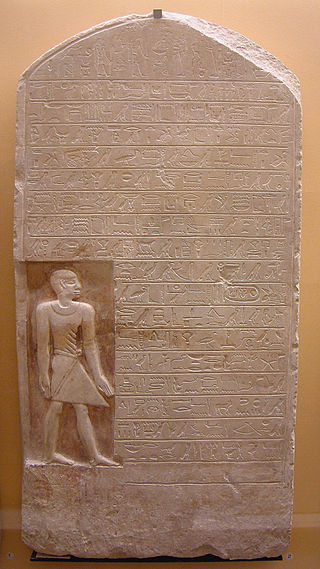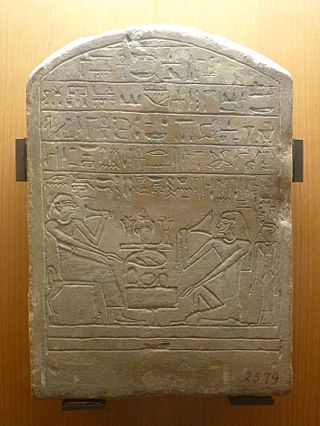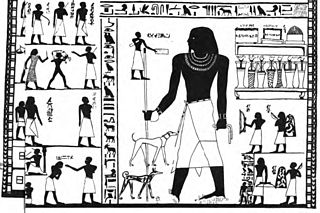Related Research Articles

Amenemhat III, also known as Amenemhet III, was a pharaoh of ancient Egypt and the sixth king of the Twelfth Dynasty of the Middle Kingdom. He was elevated to throne as co-regent by his father Senusret III, with whom he shared the throne as the active king for twenty years. During his reign, Egypt attained its cultural and economic zenith of the Middle Kingdom.

Userkare Khendjer was a minor king of the early Thirteenth Dynasty of Egypt during the Middle Kingdom. Khendjer possibly reigned for four to five years, archaeological attestations show that he was on the throne for at least three or four years three months and five days. Khendjer had a small pyramid built for himself in Saqqara and it is therefore likely that his capital was in Memphis.

Djedkare Isesi was a pharaoh, the eighth and penultimate ruler of the Fifth Dynasty of Egypt in the late 25th century to mid-24th century BC, during the Old Kingdom. Djedkare succeeded Menkauhor Kaiu and was in turn succeeded by Unas. His relationship to both of these pharaohs remain uncertain, although it is often conjectured that Unas was Djedkare's son, owing to the smooth transition between the two.

Nubkaure Amenemhat II, also known as Amenemhet II, was the third pharaoh of the 12th Dynasty of ancient Egypt. Although he ruled for at least 35 years, his reign is rather obscure, as well as his family relationships.

Nebtawyre Mentuhotep IV was the last king of the 11th Dynasty in the Middle Kingdom. He seems to fit into a 7-year period in the Turin Canon for which there is no recorded king.

Gebel el-Silsila or Gebel Silsileh is 65 km (40 mi) north of Aswan in Upper Egypt, where the cliffs on both sides close to the narrowest point along the length of the entire Nile. The location is between Edfu in the north towards Lower Egypt and Kom Ombo in the south towards Upper Egypt. The name Kheny means "The Place of Rowing". It was used as a major quarry site on both sides of the Nile from at least the 18th Dynasty to Greco-Roman times. Silsila is famous for its New Kingdom stelai and cenotaphs.

Ameny Qemau was an Egyptian pharaoh of the early 13th Dynasty in the late Middle Kingdom.

Ankhu was an Egyptian vizier during the early 13th Dynasty in the late Middle Kingdom. He is believed to have resided in Thebes in Upper Egypt.

Georges Albert Legrain was a French Egyptologist.

Iymeru Neferkare was the ancient Egyptian vizier under king Sobekhotep IV in the 13th Dynasty, in the Second Intermediate Period.

Senewosret-Ankh {s-n-wsrt-ꜥnḫ/snfrw} was an ancient Egyptian vizier of the Middle Kingdom, dating to the end of the Twelfth or to the beginning of the Thirteenth Dynasty.

Zamonth or Samont was an ancient Egyptian vizier who is thought to have been in office during the reign of Amenemhat III, at the end of the Twelfth Dynasty.
Amenhotep was an ancient Egyptian official with the title king's son of Kush. In this function he was the main administrator of the Nubian provinces. Amenhotep was probably in office under Thutmosis IV.

Shemay was an ancient Egyptian official and later vizier toward the end of the 8th Dynasty during the First Intermediate Period, mainly known for being the beneficiary of most of the Coptos Decrees. His career has been interpreted as a glaring sign of the extreme weakness of the central power, forced to bestow great privileges to maintain the loyalty of powerful local governors. Shemay is buried in a mudbrick mastaba just south of Coptos.

Amenemhat, often reported with his short form Ameny (Jmnjj), was an ancient Egyptian "Overlord of the Oryx nome" and chief priest during the reign of pharaoh Senusret I of the 12th Dynasty.

Several fragments belonging to the Annals of Amenemhat II are known from Memphis in Egypt. They are an important historical document for the reign of the Ancient Egyptian king Amenemhat II, but also for the history of Ancient Egypt and understanding kingship in general.

Idy was an important Ancient Egyptian high official in the Eighth Dynasty known from several sources and served the last kings of the Old Kingdom.
Sobeknakht I was an ancient Egyptian official of the Second Intermediate Period. He was the local governor at Elkab.
Ameny was an ancient Egyptian official of the Twelfth Dynasty, most likely in office under king Amenemhat II. Ameny was a great overseer of the troops and is mainly known from a series of stelae (Paris, Louvre C 35, Cairo CG 20546, London, British Museum 162 once set up at Abydos and there adorning a chapel. On these stelae, he bears the most important ranking titles of a member of the elite, foremost of action, royal sealer and sole friend. As a great overseer of the troops, he was the leading official at the royal responsible for organizing manpower that was used in military enterprises, but also for building projects. Ameny was the son of a person called Qebu. On each stelae a different wife is mentioned. These are Itet, Renefankh and Medhu. His tomb was found at Lisht, but is not yet fully excavated. The stelae of Ameny are not dated by any king's name. However, on stylistic grounds, they most likely date under king Senusret I and Amenemhat II. Some of the biographical phrases on the stelae indicate a date more precisely under the latter king.
Teti was an Ancient Egyptian vizier from the end of the Old Kingdom, around 2200 BC. He is known from his tomb excavated near the pyramid complex of king Pepi II. His tomb is a big building. There was found an inscribed false door and an inscribed obelisk; these and further inscriptions provide the name and titles of Teti. His main function was that of a vizier, but he was also father of the god, beloved of the god, hereditary prince, king's eldest son and foster child of the king. These are all rare and exceptional important titles that indicate that Teti was a powerful official. He most likely dates to the end of Pepi's II reign. He was also overseer of the granaries and overseer of the treasury, titles often held by a vizier.
References
- ↑ Jacques de Morgan, Urbain Bouriant, Georges Legrainː Catalogue des monuments et inscriptions de l'Egypte antique. Première série, Haute Egypte. Tome premier, de la frontière de Nubie à Kom Ombos, 1894, pl. 21, no. 41 and 31, no. 10 online
- ↑ Herman de Meulenaere: Contributions à la prosopographie du moyen empire, in BIFAO 81.1 (1981), pp. 77-79 online